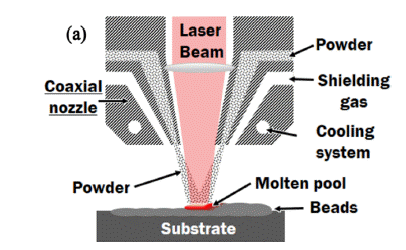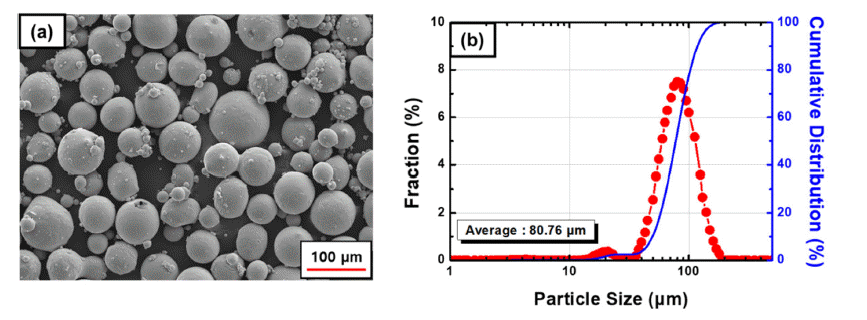- [Korean]
- Manufacturing of Fe-Mn-Al-C Based Low Mn Lightweight Steel Via Direct Energy Deposition
-
Kwang Kyu Ko, Han Sol Son, Cha Hee Jung, Hyo Ju Bae, Eun Hye Park, Jung Gi Kim, Hyunjoo Choi, Jae Bok Seol
-
J Powder Mater. 2022;29(4):320-324. Published online August 1, 2022
-
DOI: https://doi.org/10.4150/KPMI.2022.29.4.320
-
-
 Abstract Abstract
 PDF PDF
Lightweight steel is a crucial material that is being actively studied because of increased carbon emissions, tightening regulations regarding fuel efficiency, and the emergence of UAM, all of which have been recently labeled as global issues. Hence, new strategies concerning the thickness and size reduction of steel are required. In this study, we manufacture lightweight steel of the Fe-Mn-Al-C system, which has been recently studied using the DED process. By using 2.8 wt.% low-Mn lightweight steel, we attempt to solve the challenge of joining steel parts with a large amount of Mn. Among the various process variables, the laser scan power is set at 600 and 800W, and the laser scan speed is fixed at 16.67 mm/s before the experiments. Several pores and cracks are observed under both conditions, and negligibly small pores of approximately 0.5 μm are observed.
- [Korean]
- Additive Manufacturing Optimization of Directed Energy Deposition-Processed Ti-6Al-4V Alloy using Energy Density and Powder Deposition Density
-
Yukyeong Lee, Eun Sung Kim, Se-Ho Chun, Jae Bok Seol, Hyokyung Sung, Jung Seok Oh, Hyoung Seop Kim, Taekyung Lee, Tae-Hyun Nam, Jung Gi Kim
-
J Korean Powder Metall Inst. 2021;28(6):491-496. Published online December 1, 2021
-
DOI: https://doi.org/10.4150/KPMI.2021.28.6.491
-
-
279
View
-
2
Download
-
1
Citations
-
 Abstract Abstract
 PDF PDF
The process optimization of directed energy deposition (DED) has become imperative in the manufacture of reliable products. However, an energy-density-based approach without a sufficient powder feed rate hinders the attainment of an appropriate processing window for DED-processed materials. Optimizing the processing of DEDprocessed Ti-6Al- 4V alloys using energy per unit area (Eeff) and powder deposition density (PDDeff) as parameters helps overcome this problem in the present work. The experimental results show a lack of fusion, complete melting, and overmelting regions, which can be differentiated using energy per unit mass as a measure. Moreover, the optimized processing window (Eeff = 44~47 J/mm2 and PDDeff = 0.002~0.0025 g/mm2) is located within the complete melting region. This result shows that the Eeff and PDDeff-based processing optimization methodology is effective for estimating the properties of DED-processed materials. -
Citations
Citations to this article as recorded by  - Cryogenic Tensile Behavior of Ferrous Medium-entropy Alloy Additively Manufactured by Laser Powder Bed Fusion
Seungyeon Lee, Kyung Tae Kim, Ji-Hun Yu, Hyoung Seop Kim, Jae Wung Bae, Jeong Min Park
journal of Korean Powder Metallurgy Institute.2024; 31(1): 8. CrossRef
- [Korean]
- Measurement Method of Prior Austenite Grain Size of Nb-added Fe-based Alloys
-
Kwang Kyu Ko, Hyo Ju Bae, Sin Woo Jung, Hyo Kyung Sung, Jung Gi Kim, Jae Bok Seol
-
J Korean Powder Metall Inst. 2021;28(4):317-324. Published online August 1, 2021
-
DOI: https://doi.org/10.4150/KPMI.2021.28.4.317
-
-
 Abstract Abstract
 PDF PDF
High-strength low-alloy (HSLA) steels show excellent toughness when trace amounts of transition elements are added. In steels, prior austenite grain size (PAGS), which is often determined by the number of added elements, is a critical factor in determining the mechanical properties of the material. In this study, we used two etching methods to measure and compare the PAGS of specimens with bainitic HSLA steels having different Nb contents These two methods were nital etching and picric acid etching. Both methods confirmed that the sample with high Nb content exhibited smaller PAGS than its low Nb counterpart because of Nb’s ability to hinder austenite recrystallization at high temperatures. Although both etching approaches are beneficial to PAGS estimation, the picric acid etching method has the advantage of enabling observation of the interface containing Nb precipitate. By contrast, the nital etching method has the advantage of a very short etching time (5 s) in determining the PAGS, with the picric acid etching method being considerably longer (5 h).
|





